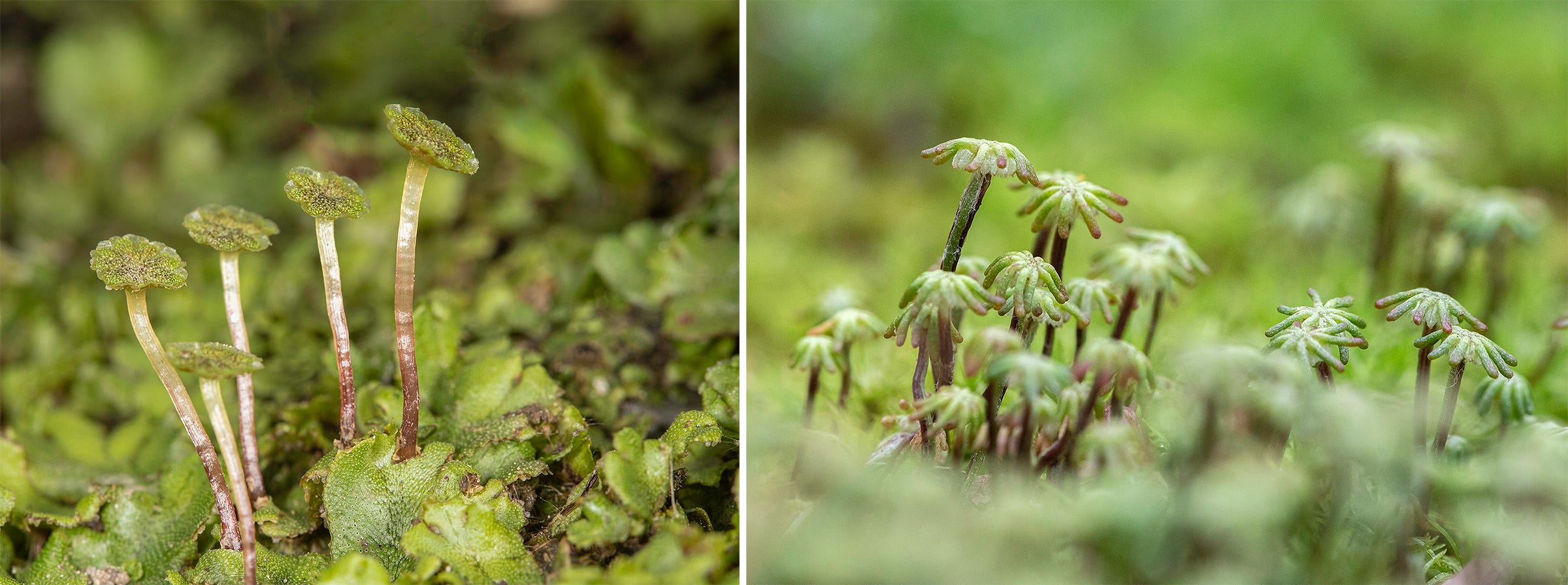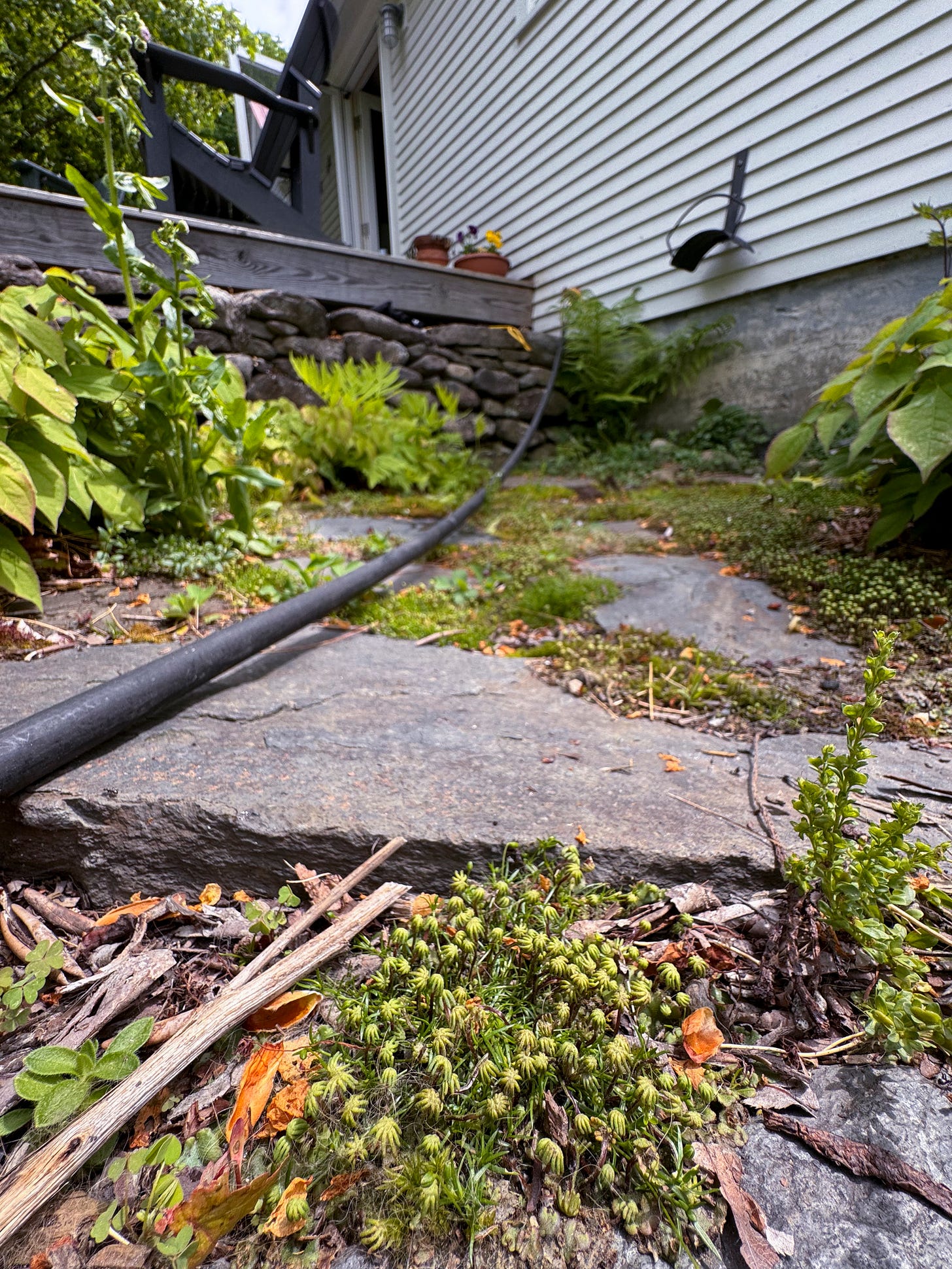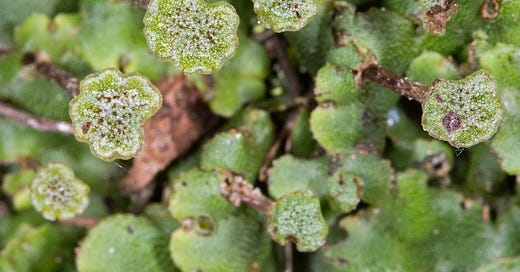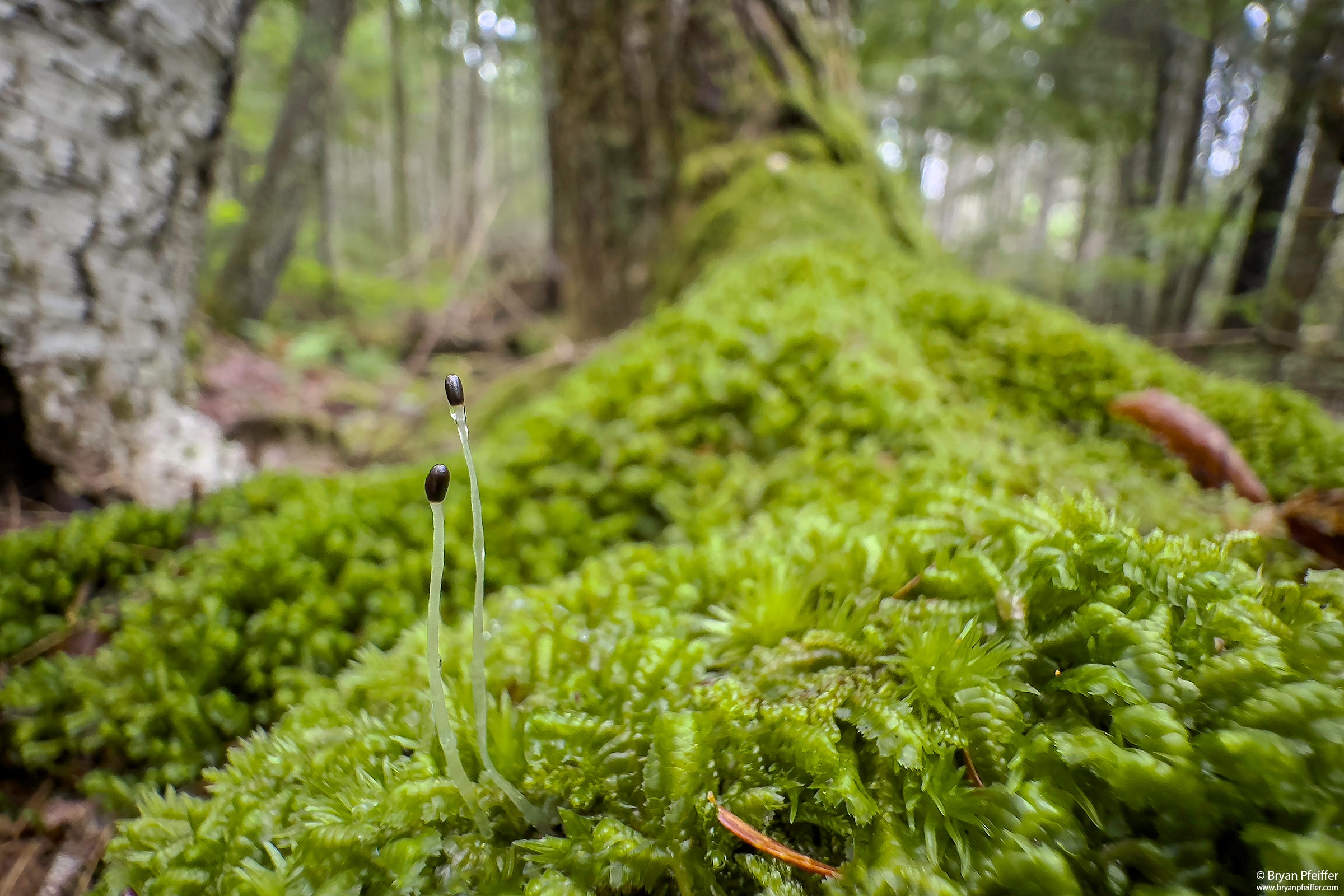IN ORDER TO WITNESS the sex life of the Common Liverwort, which goes by the charming scientific name Marchantia polymorpha, you must first of course find this plant growing in some damp or rocky place. For me this should not have been a problem.
After all, Marchantia (mar-CAN-tee-uh), as it can be affectionately known, is among the most cosmopolitan plants on Earth, growing as a flattened, spreading “thallus” that might be mistaken for a green lichen or perhaps some kind of moss. So common is Marchantia that it has become sort of the white lab rat of liverwort biologists, owing in part to its ornate reproductive structures, which seem to have inspired the botanical creativity of Theodor Seuss Geisel (Dr. Seuss).
So I took it upon myself this spring to visit known locations for Marchantia here in my home city of Montpelier, the capital of Vermont — one of them near an insurance company headquarters, another in the city’s central park, and a third near our senior center. At each site I failed to find Marchantia (or any other liverworts, for that matter).
Although this wasn’t particularly worrisome, there was some urgency to my expeditions. For one thing, on January 1, in one of my more popular essays here on Chasing Nature, I resolved to report specifically on the reproductive spectacle of Marchantia, which is unlike the plant reproduction that most of us have come to know. Among Marchantia, there are no flowers, no pollen, no birds, no bees, no pollinators whatsoever.
Marchantia and its kin descend from some of the most ancient terrestrial plants on Earth: bryophytes — the mosses, liverworts, and hornworts, all of which display profound adaptability and beauty. And before revealing to you how I ultimately did find Marchantia, which is really the point of this essay, first let’s get to the wet sex.
It begins, fundamentally, with separate male and female Marchantia plants. Lots of bryophytes get on this way. For most of the year, Marchantia, appressed to the earth, goes about its business of photosynthesis and growth without any overt reproductive inclinations. But as the season warms, male and female Marchantia plants sprout elaborate structures — each standing but a centimeter or two high and yet each a grand edifice of reproduction.

The male structures, called antheridiophores, resemble little parasols. They generate sperm. Yeah, plants can have sperm instead of pollen; these have two flagella. Similarly, the female structures, archegoniophores, resemble little palm trees. (If you’re reading on a small screen, I suggest you click the image above and zoom.) Dangling from the fronds are tiny, hidden chambers, almost like an upside-down vase, each of which contains a single egg.
You know the general story from here: Sperm journeys to egg. Fertilization. Zygote. Cell division. Embryo. More cell division. And ultimately the next generation of the organism. But among bryophytes, the embryo instead matures into what amounts to a separate plant, called a sporophyte, that features a capsule in which spores — not seeds and fruit — develop.
Among many bryophytes, especially mosses, sporophytes grow upward and feature a stalk (called a seta) and its capsule, similar to that Greater Whipwort (Bazzania trilobata), a common liverwort, pictured above. In Marchantia, sporophytes grow on the underside of the archegoniophore’s (palm-tree) limbs. The capsule eventually opens to release spores to the winds. Those that land in a suitable wet spot will go on to grow into a spreading, flat Marchantia plant (again, either male or female) — a life cycle now complete.
Fertilization
And yet how does a sperm find its egg on a separate plant? Remember, bryophytes have no pollinators — they pre-date many insects and birds and dating apps by hundreds of millions of years. Also note that a Marchantia sperm can beat its two flagella and move on its own for only about 30 to 60 minutes — then it’s done. And, nope, those male and female Marchantia reproductive structures generally aren’t rubbing up against one another or otherwise commingling. Not even dinner and a movie.
Instead, in some of the oldest sex on land, bryophytes rely on something far more ancient and fundamental to life: water. Sperm reach egg by swimming through a film of water bathing the Marchantia plants. Bryophytes basically reproduce in rainwater or dew. Raindrops landing atop those parasols can splash and launch sperm toward a nearby female Marchantia plant. And even though their journey might be merely a few inches, the vast majority of bryophyte sperm never reach an egg. That’s not a problem, however, because in Marchantia the union of one sperm and one egg can give rise to a sporophyte that will go on to produce upwards of 300,000 spores.
Even if no sperm whatsoever succeeds, Marchantia (and lots of other bryophytes) can reproduce without sex — vegetatively. Tiny clusters of cells, each called a gemma (another lovely name), can fall from the plant and go on to grow into new plants. Marchantia produces these “mini-mees” in little saucers called “gemmae cups” growing on the thallus. A water droplet landing on a cup can eject gemmae as far as 120 centimeters (about four feet) from the parent plant. Think about that the next time you suspect a single raindrop doesn’t matter much — or even whether you yourself are capable of making a big splash in the world.
Marchantia and Me (and Perhaps You)
There you have it: more than 300 million years of bryophyte reproductive strategy in about 3 minutes of reading. My objective this summer was merely to find some Marchantia and those odd reproductive structures — palm trees and parasols. Having failed at those three sites in Montpelier, I did what I usually do in May: head for the bogs. Not for Marchantia, however. I go for butterflies, dragonflies, flowers, and peace of mind. I had figured that “Marchantia and me” could wait.
We waited not long at all. On 26 May, after one of my bog romps, I went out back of the house to the garden hose in order to rinse off my muddy boots and other gear. There at my feet, in full resplendence along the stone pathway to the faucet, was a colony of female Marchantia sporting a palm forest of tiny archegoniophores. I had been walking those stones for years unaware. Nature is like that: its diversity and beauty and oddities can creep up on us when we least expect it.
Even so, my quest did not end on the garden path, where female Marchantia plants had been doing fine on their own without any males, spreading by way of gemmae cups. I was still on the lookout for male Marchantia.
Days later, I happened to visit a friend, the writer David Dobbs, at his home here in Montpelier. Our conversation didn’t get far. After taking my seat across from Dave in his garden, I glanced down at the patio’s stonework. There before me lay a patch of Marchantia — males displaying their summer parasols. The editor Alice Colwell, married to Dave, had known about the liverwort, and liked the notion of its cohabitating with her garden’s lungwort (plants in the genus Pulmonaria displaying deep blue and fuchsia flowers ).
My 2024 New Year’s resolution is now complete. I bring you male and female liverwort reproductive structures: merely an inch or so in stature, and yet to my mind an apotheosis of discovery and oddity.
So get your boots muddy; stop to chat with a neighbor. To be sure, the wild awaits you “out there” and beyond. But sometimes opportunity lies as well wherever we plant our own two feet (or rinse off our boots).

Postscripts and References
As I later discovered, Marchantia seems to have adapted to human disturbance. It can do well when its spores settle upon wet or damp garden stonework. Sometimes it shows up as a hitchhiker in commercial potted plants. Even if I had known of such versatility, I suspect my discovery would have been no less wonderful.
A 24-second time-lapse video of Marchantia growing — with the female archegoniophores emerging at its conclusion. Worth watching.
Find Marchantia polymorpha growing near you thanks to this iNaturalist map.
A crucial references for me here: Marchantia polymorpha: Taxonomy, Phylogeny and Morphology of a Model System. Plant Cell Physiol. 57(2): 230–256 (2016) https://doi.org/10.1093/pcp/pcv192. I also owe gratitude to the bryophyte wisdom of Dorothy Allard and Fred Olday.
There are several ways to pronounce Marchantia; two others I’ve overheard botanists using are mar-CAN-chee-uh and mar-CHAN-tee-uh.
Finally, as editors among you no doubt notice, in my capitalizing of common names of organisms here on Chasing Nature, I’m defying most writing style manuals. Hey, it’s my Substack — I set style. I’ll write at some point on my reasoning about common names. And although I slip up sometimes (owing to my former life as a print journalist following AP style), I’m now on Team Oxford Comma, except in headlines. (Dave Dobbs calls the opposing team “Team Loser.”)
The Post That Started All This
A New Year and an Ancient Plant
IF ONLY REDEMPTION were as easy and inevitable as the passing of time. So instead of the ceremonial resolutions we make for ourselves today, maybe it’s enough for some of us to have merely survived another year on this wonderful and troubled earth.










Excellent post, I really like Marchantia, it grows in several places in Edinburgh, including a few of the cemeteries. (I shared a photo in this blog post, alongside a few photos of cherry trees https://craftygreenpoet.blogspot.com/2022/04/cherry-blossom-everywhere.html) I didn't know all the details about the reproduction though, so thanks for sharing that.
I usually find them in greenhouses... easy to see there. More challenging to find in the wilds as there are so many distractions. I am slowing down and that helps. Perhaps it is easier to pace myself after 80 years of looking. Age has its rewards. Thank you for sharing your insights and experiences here through words and pictures you create. Much appreciated.